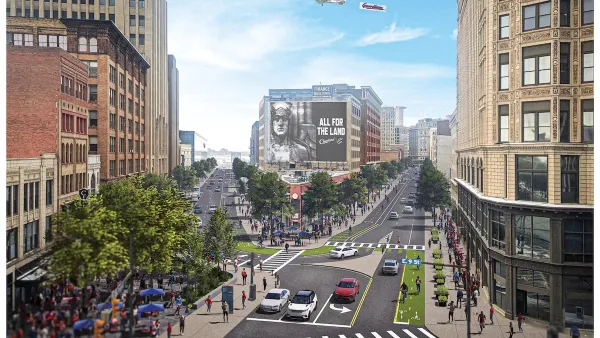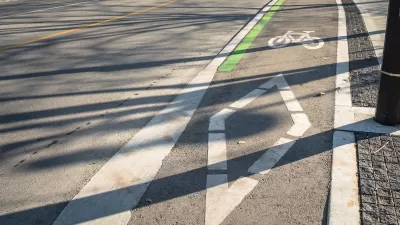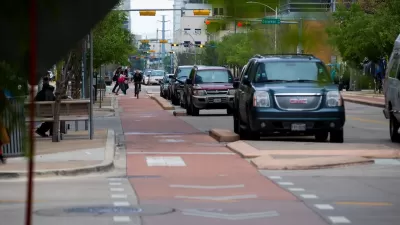A photo of a "backwards" buffered bike lane in Cleveland prompts commentary from the planning community. What is gained by separating bike lane and curb?

Cleveland is experimenting with an interesting design for bike lanes, one where a marked buffer lies not between bikes and vehicles, but between bikes and curb. Please see the article for a photo of the actual situation in Cleveland. It differs a lot from the usual buffered lane. From the article by Michael Andersen: "If you've got at least two feet of roadway to spare, you lay down some hash marks between car and bike lanes and double the comfort of biking on a street."
Nathan Wilkes of the Austin transportation department remarked, "The only use I have seen as shown in the photo is if there were parked cars to the right of the bicycle lane where there was more concern about the door zone than the moving traffic. In short it looks to be a waste of buffer material applied incorrectly."
Cleveland engineers argued that their design reduces the chance of cars turning right in front of bikes. Other reasons for the curious design might include using the wind from passing trucks to clear debris, or to make plowing snow easier.
FULL STORY: ‘Seems to be in the wrong place’: Peers react to Cleveland’s unusual bike lane

Planetizen Federal Action Tracker
A weekly monitor of how Trump’s orders and actions are impacting planners and planning in America.

Restaurant Patios Were a Pandemic Win — Why Were They so Hard to Keep?
Social distancing requirements and changes in travel patterns prompted cities to pilot new uses for street and sidewalk space. Then it got complicated.

Maui's Vacation Rental Debate Turns Ugly
Verbal attacks, misinformation campaigns and fistfights plague a high-stakes debate to convert thousands of vacation rentals into long-term housing.

In California Battle of Housing vs. Environment, Housing Just Won
A new state law significantly limits the power of CEQA, an environmental review law that served as a powerful tool for blocking new development.

Boulder Eliminates Parking Minimums Citywide
Officials estimate the cost of building a single underground parking space at up to $100,000.

Orange County, Florida Adopts Largest US “Sprawl Repair” Code
The ‘Orange Code’ seeks to rectify decades of sprawl-inducing, car-oriented development.
Urban Design for Planners 1: Software Tools
This six-course series explores essential urban design concepts using open source software and equips planners with the tools they need to participate fully in the urban design process.
Planning for Universal Design
Learn the tools for implementing Universal Design in planning regulations.
Heyer Gruel & Associates PA
JM Goldson LLC
Custer County Colorado
City of Camden Redevelopment Agency
City of Astoria
Transportation Research & Education Center (TREC) at Portland State University
Camden Redevelopment Agency
City of Claremont
Municipality of Princeton (NJ)





























